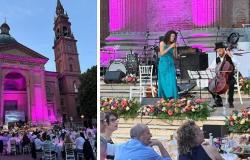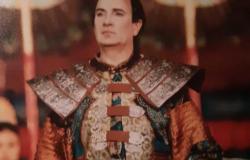A book and a future itinerary in the Marche region of historical, cultural and religious interest
On 27 June in Ancona the presentation of Fernando Frezzotti’s volume, a possible epilogue to the “Lauretana question”, as part of the Libri FuoriTeca review of the Marche Regional Council
The Library of the Marche Regional Council presents the book for the “Libri FuoriTeca” exhibition “The Way of Angels”, Thursday 27 June 2024 at 6.00 pm at the Palazzo degli Anziani in Ancona (Piazza Benvenuto Stracca 2), in the presence of the Author, Fernando Frezzotti And with the interventions of Giorgio Manganipublisher and Alessio Ferrari Angelo-Comnenus of Thessaly and Epirus, co-editor. Frezzotti will illustrate the extraordinary involvement of the Marche Region, of which Loreto is at the centre, in the historical event of the transport of the Holy House.
The historical reconstruction of the translation of the Holy Stones with the role played by the Anjou, the Grand Masters of the Temple, the Angelo-Comnenus Despots of Epirus and Thessaly and, above all, the rereading of the biographies of the commissioning popes Gregory Pope of the “great refusal”, together with the decisive iconographic confirmations, he is in fact the object and novelty of the volume “The Way of the Angels – The translation of the Stones of the Holy House”.
The Holy House of Loreto: perhaps the most important Christian relic in the world. His placement of Mary’s house in the Marche sanctuary has always been balanced between history and legend: transported for “angelic ministry” in 1294 from Nazareth to this hill overlooking the Adriatic to the east. If from the believer’s point of view, adhesion to the miracle does not pose doubts of devotion, safeguarded today in Loreto by the Capuchin Friars and the Pontifical Delegation led by an archbishop, since the beginning there has however been a so-called. Loreto question on its authenticity. This has produced an infinite series of sterile stances, which ultimately have been remedied with the birth of the Universal Congregation of the Holy House (which promotes the Marian-Lauretan cult and the College of perpetual defense of the Holy House), whose activities culminated with the archaeological excavations in Loreto of 1962-1965. These, however, not proving to be conclusive, have not prevented the continuation of heated and irreconcilable clashes between those who, on the one hand, a priori support the authenticity of the Holy House, and those who, on the other, would like to prejudicially relegate it to a “historical fake”. .
Various hypotheses would have finally revealed a less legendary transport of the house to Loreto, by the family of the Angelo-Comnenus Ducas, former emperors of Constantinople, and subsequently despots of Epirus and Thessaly. The investigation conducted by Fernando Frezzotti contemplates and qualifies these hypotheses. Before arriving in the Marche, the Holy House was guarded by the Templars first in Cyprus (1273-1283), then in the period 1283-1291, in Pyli, in Thessaly of the “Sebastocrates” Giovanni Angelo-Comneno, near the Porta Panagià basilica, built for this purpose and still exists. From 1291 to 1294, with the Templars engaged in the extreme defense of the Holy Land, temporary custody was entrusted to John’s half-brother, Nicephorus. He carried out the transfer of the stones to Arta, in Epirus, the capital of his principality, equipping for this purpose, in all probability, the splendid Basilica of the Annunciation, today a UNESCO heritage site, a very particular church, present in all the books of architecture.
“The Way of Angels”: the reconstruction of a journey
The book completes and systematizes Frezzotti’s studies published since 2018, confirming the role played by the Holy House as a bridge between East and West and, above all, as a testimony of the undivided Church. A role supported by years of work by the descendants of the Angelo-Comneno family and culminated in the transfer led by Bartolomeo (1254-1321), founder of the family branch of the “Marca Anconitana”.
The role of the Constantinian Angelic Academy
The Angelic Constantinian Academy is still linked and dedicated to that role today. “The historical reconstruction of the Translation of the Holy House by Fernando Frezzotti – he said Alexios Angelo-Comnenus – it is the definitive confirmation of what could have been defined as a consolidated awareness. Undoubtedly it had come to us from those who preceded us, but none of us anymore knew who, when, where, why and how. The Holy House of Loreto finally regains its true role, the one that it has lacked up to now, that is, as a cultural bridge between East and West and that, even more profound and spiritual, of the highest witness of the undivided Church”. “To this role – he said again – my family contributed decisively in the 13th century through the varied events that characterized the translation of the Holy House between Thessaly and Epirus for eleven years and then definitively arrived in Loreto accompanied by Bartolomeo, founder of that branch of the “Marca” family Anconitana” where I come from. Our Academy was and is aimed at this same role as my grandfather and my mother wanted by creating the scientific journal in cl in 1997. At ANVUR “Studies on the Christian East” and how we understand it today”.
So there‘Author: “The Way of the Angels is a historical-geopolitical investigation into the Translation of the Holy House, the operation that allowed its rescue from Nazareth, but also its unplanned arrival in Loreto. The analysis, on the one hand, confirmed the authenticity of the relic (thus putting an end to the so-called “Lauretana question”), on the other hand, it thoroughly highlighted the commissioning, governance, execution, custody, related historical contexts, itineraries and stops , made it possible to identify the true protagonists in their respective roles: the Angelo-Comnenus of Thessaly and Epirus, two of the most famous Templar Grand Masters and two Popes: Gregory X and Celestine V. For the latter it does not appear at all risky to postulate a complete reformulation of the historical judgment on life and pontificate. The investigation, in its last phase, also covered the iconographic aspects of the Translation, with numerous and surprising confirmations of the historical picture that emerged, found in numerous pictorial creations (see the cover image) and even in the cycle of frescoes interior of the Holy House”.
A cultural, historical, religious itinerary
Based on the research carried out over the years, the so-called “Via degli Angeli“: the itinerary that the Holy House traveled in the Marche before being definitively placed in Loreto on the orders of Celestine Vbut also the itinerary followed by Ithamar/Margherita, daughter of Nicephorus, Despot of Epirus, who married Philip of Anjou in Naples. The stones of her Holy House were, in fact, part of her wedding dowry. Realizing that the stones would not follow her, she separated from them, but her passage through the Marche left indelible traces. “The Way of Angels” it doesn’t stop there. It is also the reconstruction of the historical context that made a partial deposition to S. Firmano of Montelupone necessary and the discovery of the language that has come down to us to communicate it to us, as well as the discovery of the link that, in the sign of the Translation and its commissioner Celestine V, it unites the locality of “Angeli di Varano” (AN) with Pacentro (AQ) and its centuries-old “Corsa degli Zingari”.
More generally, the “Via degli Angeli” is a cultural, historical and religious route for all those interested in knowing the history of the transport of the Holy Marian Relic. A route that will connect the Marche with nearby Greece, because here the Holy House was guarded and defended by the Angelo Comnenus of Epirus and Thessaly, but also with Cyprus, where the relic was transported by the Templars to save it from Islamic fury and, finally, with the Holy Land, reinvigorating Ancona’s ancient vocation as a gateway to the East.
THE ENTRY TO THE PRESENTATION AND FREE






